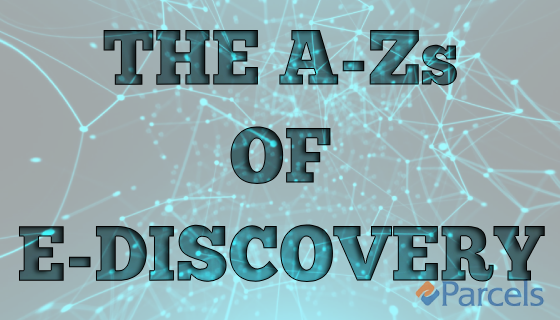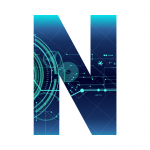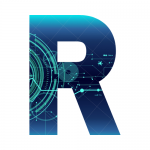
Industry-specific articles use jargon and acronyms that can be intimidating at first glance. We wanted to make eDiscovery a little easier to understand, so we created this blog series to take you through the most common terminology used in the eDiscovery world.

Media: Media is the kind of device used to store electronic information. Hard drives, backup tapes, and DVDs are all examples.
Meet & Confer: This is a required conversation in federal courts at the beginning of a caseAt the beginning of a case. It’s held for lawyers to discuss discovery and to reach an agreement on preliminary matters (such as forms of production and dates for depositions). If you are in need of some tips on Meet and Confer Conferences, look no further than the American Bar Association.
Metadata: This is data within data… about the original data. For example, a word document will have metadata that is unseen to the user. For further information, check out our blog post about it!

Native Format: When electronic files are originally created and maintained in the same format, they are in the native format. This sustains the metadata and other details that can disappear when converted to other formats.
Near-Duplicate: A document is near-duplicate when it has a high percentage of the same content as another document. Near-duplicate content is identified during the data reduction process and involves some subjective decisions by the client.
Near-Native: Near-native formatted documents are functionally the same as native (see above). Because some things can’t be produced in the application that created them, it’s called the next best thing: near-native. An email attachment is an example of this: a photo or document can be previewed when you click on it. By clicking the attachment to preview, you’re viewing it without having to open or download another software. You’re viewing the attachment in a near-native view.
Normalization: Basically, normalization is re-formatting data for the purpose of standardizing it. Still don’t get it? Here’s an example.

Operating System: All devices use an operating system, whether it’s a desktop or mobile device. This is the software that directs the overall activity of a computer and performs basic tasks, like keeping track of files/directories. It also controls security and peripheral devices, and ensures that different programs/users are able to run at the same time without interference. Examples of operating systems are MS-DOS, Windows, Linux, and Macintosh (iOS).
Optical Character Recognition (OCR): OCR is how printed images and copy are converted into electronic text so documents can be electronically edited and searched. You can do all kinds of stuff when a printed page is in machine readable text form.

Parent Document: This is the main folder or document that is used or seen, and can have other documents or folders within it. It’s like when you create a folder for photos. The main “Photos” folder is the parent document, while the specific folders such as “Summer 2018” and “Office Holiday Party” are the child documents.
Personal Storage Table (.pst): A compressed file format used to store copies of messages, calendar events, and other items within Microsoft software (like Microsoft Outlook, Microsoft Exchange Client, and Windows Messaging) — or, in the most basic of terms, it’s how Outlook stores your email.
Precision: Precision is a measure of how often an algorithm accurately predicts a document to be responsive.
Predictive Coding: In order to automate portions of an eDiscovery document review, predictive coding is used to reduce how many non-responsive/irrelevant documents there are. This is a process that combines machine-learning technology and workflow methods that use keyword searches, filters, and samples.
Preservation Demand: This is a document addressed to your adversary demanding that he or she keep evidence safe, prevent it from being lost or destroyed, and includes a date to seek sanctions.
Privilege: An advantage or right that is exclusively used for legal purposes.
Processing: Processing can differ depending on the application being used, but ultimately, it is the eDiscovery workflow that formats collected ESI so that it can be culled and searched in a review tool. It typically includes: the extraction of files from folders (.pst and .zip formats); the separation of attachments; the conversion of files to formats the review tool can read; and the extraction of text and metadata. Drop us a line if you’re ever in need of some process-driven results.
Production: This when the required party produces and delivers the necessary documents and electronically stored information to the opposing counsel or requesting party; these documents and ESI should meet the criteria of the discovery request.

Quick Peek Agreement: An agreement made where you schedule a time to sit with your opponent and look at certain documents in the same room in order to form a new agreement about what to do with those documents. Here are some things that should be included in a Quick Peek Agreement.

Recall: A recall is the percentage of the amount of relevant documents that appeared during search results.
Redact: Redacting is the purposeful act of covering passages within a document that are viewed as privileged, proprietary, or confidential.
Relational Database: Relational databases run your bank account, your email account, your smartphone app, your Facebook account, your doctor’s medical records system, and generally everything else in the world, including many of the things that are valuable in eDiscovery. We highly recommend that you learn a bit about relational databases and the lingo associated with them.
Review Platform: This is software that is used to examine electronic evidence, and can be hosted in a cloud or on a desktop. For example, Relativity offers a cloud based solution RelativityOne®, or an on premise solution, Relativity®.

Search: You know what this is. You do it every day. It’s looking within a data set by using a query. Most types include simple keyword and concept searches. Coveo has a great list of commonly used search queries.
Slack Space: The space you still have available on a device, or, in other words, the space you’re trying so desperately to get back on your phone.
Social Discovery: Did you think your social media was safe? Think again. Social discovery is the discovery of electronically stored information on social media sites and applications (Facebook, Twitter, YouTube, LinkedIn, Instagram).
Spoliation: The destruction or alteration of data that may be pertinent to a legal matter. This does not apply to the destruction of data during the normal course of a pre-set retention policy.
Structured Data: Data stored in a structured format such as a database or spreadsheet.
System Files: Files created by the computer (not the user), such as system libraries, icons, themes, and device drivers.

Tagging: There are two different kinds of tagging: within a review database, and within a social media platform. Within a review database, it’s the act of assigning classifications of relevance or privilege to at least one document. Within a social media platform, it’s when you put a hashtag on something.
Tagged Image File Format (TIFF): A commonly used file format for storing bitmap images and for scanned hard copy documents. To learn more, here’s a chart that shows the differences between various image formats.
Thread: A string or chain of email conversation(s), beginning with the initial email and all the other emails related to it, such as replies or forwards being exchanged between the senders and recipients.
That’s a wrap for this month’s eDiscovery terms! We’ll be back with The A to Z’s of eDiscovery: U-Z in July.
Need to catch up? The A-Z’s of eDiscovery: A-D || The A-Z’s of eDiscovery: E-L
< Return to News